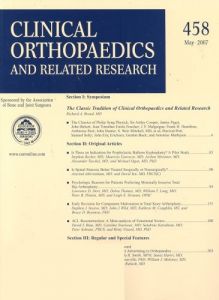Does Limb Preconditioning Reduce Pain After Total Knee Arthroplasty? A Randomized, Double-blind Study
Stavros G. Memtsoudis MD, PhD, Ottokar Stundner MD, Daniel Yoo MS, Alejandro Gonzalez Della Valle MD, Friedrich Boettner MD, Anna Maria Bombardieri MD, PhD, Kethy Jules-Elysee MD, Lazaros Poultsides MD, MS, PhD, Yan Ma PhD, Thomas P. Sculco MD
Department of Anesthesiology, Hospital for Special Surgery, Weill Medical College of Cornell University, 535 East 70th Street, New York, NY, 10021, USA
Therapeutic Level 2 Randomized Control Trial
Clin Orthop Related Res 2014 May;472(5):1467-74. doi: 10.1007/s11999-013-3106-4.

Materials and Methods
POPULATION-
- 60 patients scheduled to undergo unilateral TKA under tourniquet were included in this study. Surgeries were done under tourniquet inflation to 250 mmHg.
- A standard midline incision with a medial parapatellar arthrotomy was used. Posterior-stabilized prosthetic design with patellar resurfacing was used for all patients. Implants were chosen by the surgeon.
- Patients received standard pre(12.5mg bupivacaine 0.5%)and postoperative analgesia (FNB treatment: 30 mL bupivacaine 0.25% with epinephrine 1:200,000) via epidural catheter
Intervention:
- After completion of neuraxial anesthesia and nerve blockades, patients underwent the preconditioning procedure.
- This consisted of 5 minute inflation of a tourniquet around the target surgery area, followed by deflation and a 5 minute reperfusion period.
- This preconditioning process was done during prepping and draping to avoid delaying the surgery. After the preconditioning procedure, patients underwent TKA (n=30. 30 competed follow up,).
Comparison : Following the performance of neuraxial anesthesia and nerve blockades, patients underwent their scheduled TKA. The control groups did not receive preconditioning. (n=30, 30 completed follow up).
Outcomes Measurements used: Postoperative pain, pain medication consumption, local inflammatory markers, and length of stay.
Methods RCT: Double-Blind
Time 2 days (Outcomes were assessed at tourniquet release and at 3, 6, 24, and 48 hours).
Results
- Patients in the preconditioning group had significantly less pain postoperatively at rest (mean difference = -0.71, 95% confidence interval [CI] = -1.40 to -0.02, p = 0.043) and with exercise (mean difference = -1.38, 95% CI = -2.32 to -0.44, p = 0.004), but showed no differences in analgesic consumption.
- There were no differences between the study and the control group in terms of muscle oxygenation and intraarticular levels of IL-6 and TNF-alpha as well as levels of prothrombotic markers.
- Hospitalization length and time to various physical therapy milestones were similar between the groups.
Conclusions
- Ischemic preconditioning reduces postoperative pain after TKA
Clinical Relevance
- Ischemic preconditioning can be safely used as a part of multimodal analgesic strategy.
- However, more research is required in different preconditioning strategies, elucidation of mechanisms, safety profiles, and cost-effectiveness of this maneuver.
Ref
1. http://www.ncbi.nlm.nih.gov/pubmed/23761178
2. www.myorthoevidence.com
We experience good with intra operative bupivacaine infiltration to capsule is better than epidural analgesia. so we are following it.